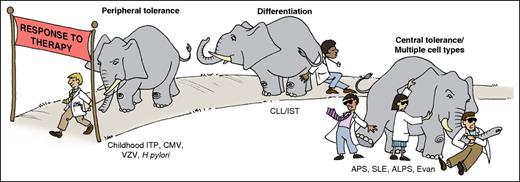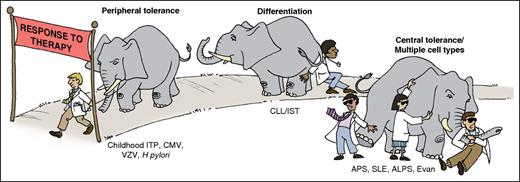In this issue of Blood, Cuker and Neunert describe their tiered approach to the treatment of refractory immune thrombocytopenia (ITP), and Mahévas et al describe the characteristics and outcomes of patients with ITP refractory to splenectomy, rituximab, and maximal doses of thrombopoietin receptor agonists (TRAs), observing excellent responses to a combination of TRAs with immunosuppression.1,2
Relationship between pathogenic mechanisms and clinical responses in ITP. The pathogenesis of ITP involves multiple aspects of immune dysregulation, involving several types of cells (B and T lymphocytes, dendritic cells, plasma cells) and resulting in both shortened platelet survival and inhibition of platelet production. In theory, the pathogenesis of childhood ITP or ITP that follows viral infections is less complex, and affects primarily peripheral tolerance. This form of ITP responds more readily to therapy or may remit spontaneously. In contrast, the pathogenesis of ITP in which there is a differentiation block or loss of central tolerance, such as in patients with neoplasia or autoimmune disease, is poorly understood and multifaceted, making therapy of such individuals more difficult. In such cases, combination therapy targeting more than 1 arm of the maladaptive immune response may be effective. ALPS, autoimmune lymphoproliferative syndrome; APS, antiphospholipid syndrome; CLL, chronic lymphocytic leukemia; CMV, cytomegalovirus; Evans, Evans syndrome; H pylori, Helicobacter pylori; IST, immunosuppressive therapy; SLE, systemic lupus erythematosus; VZV, varicella-zoster virus. Professional illustration by Patrick Lane, ScEYEnce Studios.
Relationship between pathogenic mechanisms and clinical responses in ITP. The pathogenesis of ITP involves multiple aspects of immune dysregulation, involving several types of cells (B and T lymphocytes, dendritic cells, plasma cells) and resulting in both shortened platelet survival and inhibition of platelet production. In theory, the pathogenesis of childhood ITP or ITP that follows viral infections is less complex, and affects primarily peripheral tolerance. This form of ITP responds more readily to therapy or may remit spontaneously. In contrast, the pathogenesis of ITP in which there is a differentiation block or loss of central tolerance, such as in patients with neoplasia or autoimmune disease, is poorly understood and multifaceted, making therapy of such individuals more difficult. In such cases, combination therapy targeting more than 1 arm of the maladaptive immune response may be effective. ALPS, autoimmune lymphoproliferative syndrome; APS, antiphospholipid syndrome; CLL, chronic lymphocytic leukemia; CMV, cytomegalovirus; Evans, Evans syndrome; H pylori, Helicobacter pylori; IST, immunosuppressive therapy; SLE, systemic lupus erythematosus; VZV, varicella-zoster virus. Professional illustration by Patrick Lane, ScEYEnce Studios.
Recent insights into the pathogenic mechanisms underlying ITP and the advent of rituximab and TRAs have changed the paradigm of ITP treatment. Still, a challenging minority of patients remains refractory to multiple lines of treatment and develops chronic thrombocytopenia, hemorrhage, poor health-related quality of life, and high mortality.3 Refractory ITP itself remains an elusive concept. The 2009 International Working Group (IWG) definition of refractory ITP, incorporated by Cuker and Neunert, includes patients who fail or relapse after splenectomy and require treatment to prevent bleeding.4 This definition, however, fails to account for patients who are unwilling or unable to undergo splenectomy, the use of rituximab, or TRAs (eltrombopag and romiplostim) in the second-line setting,5 or refractoriness to rescue therapy. The report by Mahévas et al focuses on multirefractory ITP, which the authors define as symptomatic ITP not responding to splenectomy, rituximab, and maximum doses of TRAs. We believe that the latter definition is more relevant in today’s treatment landscape because it identifies patients who are clearly refractory to standard treatments, and suggests that re-evaluation of the IWG definition of refractory ITP is needed.
In their “How I Treat” article, Cuker and Neunert describe a tiered approach to patients who fail, or are ineligible for, splenectomy: tier 1 includes agents such as low-dose steroids, rituximab, and TRAs that have strong evidence to support their use, tier 2 includes immunosuppressants (6-mercaptopurine, azathioprine, vincristine, and others), and danazol, for which there is less evidence of efficacy (often used in combination with tier 1 agents when monotherapy fails). Tier 3 strategies include plasmapheresis, stem cell transplantation, and interferon. Patient preference, comorbidities, and cost play a significant role in these decisions.
The study by Mahévas and colleagues reports the results of a multicenter analysis of 37 patients with multirefractory (to splenectomy, rituximab, and TRA) ITP compared with a matched group of 183 historical controls. Multirefractory patients had a significantly higher rate of secondary ITP (35.1%) than controls (8.7%). Even among patients with primary multirefractory ITP, half had biologic features of autoimmunity such as positive direct antiglobulin tests or antinuclear antibodies. Multirefractory patients also had higher rates of bleeding at onset (odds ratio, 3.54 [95% confidence interval, 1.12-11.23]; P = .032), low response rates to corticosteroids (68.6% vs 91.6%, P = .002), and a high mortality rate of 14%, only slightly lower than the 17.6% mortality rate among patients refractory to splenectomy reported by McMillan and Durette over a decade ago in the pre-TRA era.3 However, an important finding in this study is that 7 of 10 patients with multirefractory ITP who were treated with a combination of TRA and 1 of several immunosuppressive therapies (5 mycophenolate, 1 cyclosporine, 2 cyclophosphamide, 1 azathioprine, and 1 hematopoietic stem cell transplantation) responded.
An array of diverse immunologic abnormalities involving T and B lymphocytes, dendritic cells, and plasma cells may contribute in different extents to the pathogenesis of ITP. Cines et al have suggested that ITP is not a specific disorder, but a “syndrome,” and broadly categorized immune tolerance defects in this disorder as central defects that arise during early development, differentiation blocks with skewed B-cell subsets, and/or a loss of peripheral tolerance in the setting of immune stimulation.6 Patients in whom acquired defects in peripheral tolerance checkpoints result in antibody-mediated platelet clearance and decreased megakaryopoiesis tend to respond well to conventional ITP therapy, frequently with durable responses, because the antigenic stimulus for autoimmunity may not be persistent. In contrast, patients with underlying autoimmune disorders and/or hematologic malignancies demonstrate a loss of central tolerance and differentiation blocks6 ; these patients have poor and short-lived responses to immune-directed therapy because additional cell types are involved in disease pathogenesis and the implicated lymphocyte repertoire is largely autoreactive and able to reconstitute rapidly after therapy (see figure). As demonstrated by this and other reports,7,8 combination therapy directed at multiple arms of the immune response, along with TRAs, improves response rates. This is an important observation, though treatment of refractory ITP nevertheless remains reminiscent of the story of the “blind men and the elephant,” in which a group of blind men touch different parts of an elephant, and when they compare notes find they are in complete disagreement. Unfortunately, personalized medicine has not yet been brought to bear on the management of ITP, though undoubtedly improved understanding of the mechanisms underlying autoreactivity could suggest targeted therapies with improved outcomes.
With new insights come new questions. Which immunosuppressive therapies are best combined with TRAs? Can we identify the predominant pathogenic mechanisms in individual patients to personalize therapy? Practically speaking, we suggest new definitions for refractory ITP in the era of TRAs that will keep everyone on the same page. We propose that ITP that fails or relapses after splenectomy be termed splenectomy-resistant ITP, whereas the term refractory ITP should be reserved for patients with persistent thrombocytopenia requiring treatment even after splenectomy, rituximab, and TRA.
Conflict-of-interest disclosure: The authors declare no competing financial interests.



